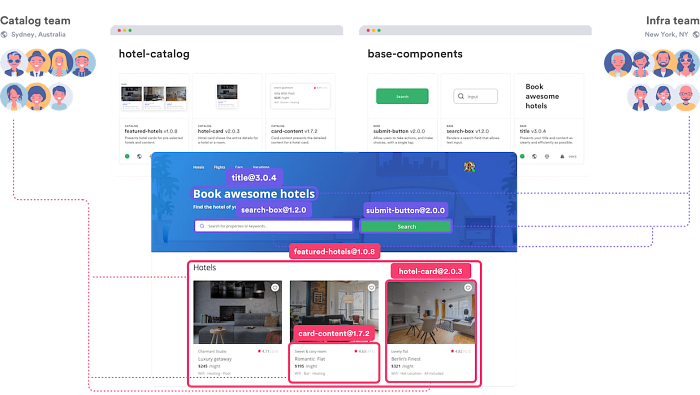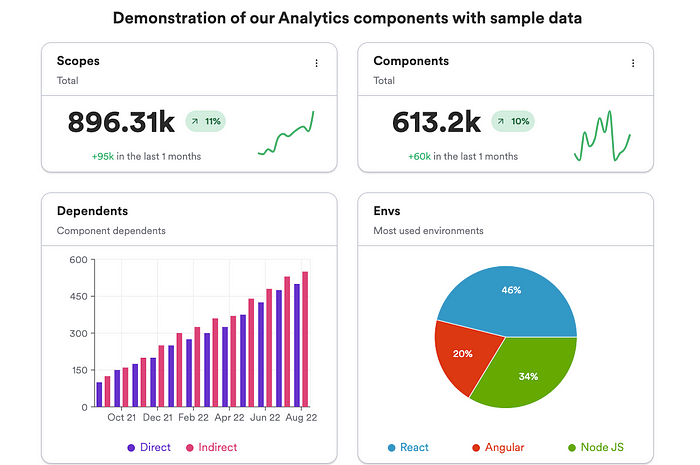

Innersource Development: A Practical Guide
source link: https://blog.bitsrc.io/innersource-development-a-practical-guide-for-2024-32c04f751279
Go to the source link to view the article. You can view the picture content, updated content and better typesetting reading experience. If the link is broken, please click the button below to view the snapshot at that time.
Innersource Development: A Practical Guide

Innersource development has revolutionized the way organizations approach software development, blending the best practices of open source with the proprietary needs of companies. As we navigate 2024, the success of innersource hinges on two critical concepts: modularity and a shared development platform. Bit emerges as a pivotal engine for innersource, providing the necessary foundations, technology, and workflows. This guide explores how Bit seamlessly facilitates each aspect of innersource, offering a practical roadmap for organizations aiming to leverage these practices.
Understanding Innersource
Innersource is a transformative approach that integrates the best practices of open source into the proprietary environment of an organization. It’s a strategy that encourages cross-team participation, contribution to internal projects, and a culture of transparency and collaboration. This approach not only enhances code quality and accelerates innovation but also breaks down traditional silos within organizations.
Key Elements of Innersource
Visibility and Discovery: A fundamental aspect of innersource is ensuring that projects and codebases are visible and accessible to all members of the organization. This transparency enables developers to find and utilize existing solutions, reducing redundant efforts and fostering a culture of reuse and collaboration.
Collaboration and Communication: Effective innersource practices hinge on open communication channels and collaborative platforms that facilitate contributions from various stakeholders. By streamlining the review and contribution process, organizations can harness the collective expertise of their workforce, leading to more innovative and well-rounded solutions.
Code Reuse and Modularity: At the core of innersource is the emphasis on modular component development. This approach allows for the creation of reusable code blocks that can be integrated across multiple projects. By encouraging modularity, organizations can speed up the development process, reduce errors, and increase the overall quality of their software. Fortune-500 Bit customers report up to 80% faster TTM via code reuse.
Shared Development Platform: Implementing a shared development platform is crucial for supporting the innersource model. Such a platform acts as a centralized hub for code sharing, project management, and collaboration, enabling seamless integration of contributions from across the organization. While various tools can facilitate this, Bit, for example, stands out by offering a comprehensive solution that emphasizes modularity and ease of use through its UI and CLI tools, making it an ideal choice for organizations looking to streamline their innersource initiatives.
The Role of Innersource in Modern Software Development
In today’s fast-paced and ever-evolving technology landscape, innersource represents a strategic advantage. It allows organizations to adapt quickly to changes, leverage internal knowledge, and foster a dynamic and innovative development environment. By adopting innersource practices, companies can replicate the success seen in open source projects, where diverse contributions lead to robust and high-quality software solutions.
Innersource demystifies the software development process within large organizations, where teams often operate in isolation. By aligning with an innersource model, these teams can unify their development efforts, aligning with best practices and shared goals. The adoption of tools that support this collaborative model is essential, and while Bit is an excellent example of such a tool, the focus remains on the overarching principles of innersource and how they can be best implemented within an organization’s unique context.
Benefits of Innersource
Innersourcing transforms how organizations approach software development, offering a plethora of benefits that not only streamline processes but also enhance product quality and team dynamics. Bit, as a platform, plays a pivotal role in realizing these benefits by providing the necessary infrastructure and tools for effective innersource practices.
More Efficient and Effective Development
Innersource promotes a more streamlined development process, allowing teams to leverage shared components and collaborate more closely. Bit accelerates this by making features, pages, and user experiences easily discoverable and reusable across teams, thus reducing redundancy and enhancing efficiency.
Faster Time-to-Market
By facilitating better collaboration and component reuse, innersource significantly shortens the development cycle. Bit supports faster time-to-market by enabling continuous integration and deployment, ensuring that updates and new features can be released swiftly.
Reduced Development Costs
The reuse of components and collaborative problem-solving inherent in innersourcing can lead to substantial reductions in development costs. Bit further minimizes expenses by providing a unified platform that reduces the need for multiple tools and streamlines the development workflow.
Overcoming Organizational Unit Boundaries
Innersource encourages collaboration beyond traditional departmental borders, fostering innovation and knowledge sharing. Bit makes it easier for teams to transcend these boundaries by hosting shared components and facilitating cross-team contributions.
Cost and Risk Sharing Among Organizational Units
With innersource, the investment in developing new features and components is distributed across the organization, as is the risk associated with new initiatives. Bit’s collaborative environment supports this sharing model, enabling teams to pool resources and expertise effectively.
Collaboration Across Organizational Unit Boundaries
Innersource breaks down silos and promotes a culture of open collaboration. Bit enhances this by providing a space where developers from different teams can work together on shared components, fostering a sense of unity and purpose.
Program-wide Information Exchange
A key benefit of innersource is the broad dissemination of knowledge throughout the organization. Bit supports this information exchange by making documentation and component details widely accessible, promoting an environment of continuous learning.
More Successful Reuse
Innersourcing maximizes the potential for code reuse, reducing duplication of effort and fostering a more efficient development process. Bit’s component-centric approach makes reuse more practical and successful by ensuring components are easy to find, understand, and integrate.
Use of Competences Missing at Component Providers
Innersource allows teams to tap into a wider pool of expertise, utilizing skills that may not be available within their immediate unit. Bit facilitates this by enabling teams to discover and collaborate on components that require specialized knowledge.
Independence Between Reusers and Providers
The modular nature of innersourced components ensures that teams can work independently, reducing bottlenecks and accelerating development. Bit supports this independence by providing clear interfaces for components, allowing for easy integration without the need for constant coordination.
Relief of Component Providers
By sharing the responsibility for maintaining and updating components across the organization, innersource reduces the burden on individual teams. Bit aids in this relief by automating many of the tasks associated with component management and deployment.
Better Software Product
The collaborative, open approach of innersource leads to higher-quality software products, as it incorporates diverse perspectives and expertise. Bit contributes to this by facilitating code reviews and encouraging best practices in component development and documentation.
More Innovative Development
Innersourcing fosters an environment where innovation thrives, thanks to the free exchange of ideas and the ability to build upon existing work. Bit amplifies this innovative potential by enabling teams to share and evolve components in response to emerging needs and opportunities.
More Flexible Utilization of Developers
The modular, component-based nature of innersourced projects allows for more flexible deployment of developer resources. Bit supports this flexibility by making it easier for developers to contribute to various projects as needed, without being limited by project boundaries.
Simplified Developer Deployment
Innersource simplifies the process of deploying developers across multiple projects, thanks to standardized processes and tooling. Bit streamlines developer deployment by providing a consistent platform and workflow for component development and collaboration.
Collaboration of Detached Developers
Innersource enables developers who are not co-located to collaborate effectively, bridging geographical and organizational gaps. Bit facilitates the collaboration of detached developers by providing a cloud-based platform that supports remote contribution and communication.
Enhanced Knowledge Management
One of the hallmarks of innersource is its contribution to organizational knowledge management, capturing and sharing expertise across projects. Bit enhances knowledge management by storing documentation alongside components, making it easily accessible to all developers.
Community-based Learning
Innersource fosters a learning community within the organization, where developers can grow their skills through collaboration and shared challenges. Bit supports community-based learning by providing forums for discussion, feedback, and knowledge sharing around components and development practices.
Openness and Availability of Knowledge
The open culture promoted by innersource ensures that knowledge is not hoarded but shared widely. Bit embodies this principle by making all component documentation and details openly available, encouraging a culture of transparency and continuous learning.
Higher Employee Motivation
Finally, innersourcing can lead to higher employee motivation, as developers feel more connected to their work and empowered to contribute. Bit plays a role in boosting motivation by recognizing contributions, facilitating meaningful collaboration, and providing a sense of accomplishment through shared achievements.
Innersource Engine: Composable Platform
The fusion of modularity and a shared development platform embodies the essence of successful innersourcing. These two principles, when effectively implemented, can transform the software development landscape within an organization, fostering an environment ripe for innovation, collaboration, and efficiency.
Build with a composable platform
The Power of Modularity
The concept of modularity transcends traditional development methodologies by promoting the decomposition of complex systems into smaller, independently functioning pieces. This architectural style not only simplifies understanding and enhances flexibility but also significantly reduces the barrier to entry for team members to contribute. With modularity, the focus shifts from monolithic applications to a more granular level, where components can be developed, tested, and deployed in isolation from the rest of the system. This granularity ensures that changes can be made rapidly and safely, minimizing the risk of disrupting the entire application.
In an innersourcing context, modularity enables teams across different domains or functional areas to contribute to a shared codebase without the need for comprehensive knowledge of the entire system. It allows developers to focus on their areas of expertise, bringing their best work to each component they develop or improve. Furthermore, modularity supports the reuse of code across projects, eliminating the need to reinvent the wheel for common functionalities and speeding up the development process.
The Role of a Shared Development Platform
A shared development platform acts as the linchpin in the innersourcing model, providing the infrastructure necessary for collaborative development. Such a platform, exemplified by Bit, goes beyond mere code hosting; it integrates seamlessly with the tools and workflows developers use daily. By centralizing code management, collaboration, and deployment processes, a shared platform ensures that all team members, regardless of their location or department, have equal access to the organization’s collective intelligence.
This platform underpins innersourcing practices by enabling features like forking and pull/merge requests, which are staple collaboration mechanisms in the open-source world. These features encourage contributions from across the organization, facilitating a dynamic exchange of ideas and solutions. Continuous integration and deployment (CI/CD) pipelines, integrated within the platform, automate the testing and deployment processes, ensuring that contributions are viable and do not compromise the integrity of the application.
Moreover, a shared development platform serves as a discovery mechanism for existing components and projects within the organization. Developers can easily search for and find reusable components, documentation, and previous discussions, making it simpler to build on existing work rather than starting from scratch. This not only conserves development resources but also fosters a culture of learning and continuous improvement.
Implementing Innersource
Implementing innersource successfully requires a blend of the right philosophy, tools, and practices. Bit, as a platform, is central to actualizing these requirements by offering a structured and collaborative environment tailored for innersource development.
Establishing Clear Guidelines
Using Bit, organizations can define comprehensive innersource policies that encompass component documentation, sharing protocols, and integration strategies. Bit’s structured environment brings consistency to contributions, streamlining the onboarding process for new contributors. This consistency ensures that regardless of a team member’s background, contributing to any project becomes a frictionless experience, directly supporting the innersource initiative.
Fostering an Open Culture
Bit enhances the open culture of an organization by making every contribution visible and acknowledged across the company. Through its recognition features, Bit encourages a sense of belonging and shared purpose by celebrating individual and team successes. This visibility not only motivates developers but also fosters a culture of transparency and inclusivity, essential elements of a thriving innersource ecosystem.
Providing the Right Tools
Bit emerges as a comprehensive solution that dovetails with existing workflows, offering tools for version control, code review, and continuous integration, all through a lens focused on component-based development. This integration capability ensures that the discovery and reuse of components are straightforward, significantly reducing development time and fostering a culture of efficiency and innovation. By providing a unified platform, Bit eliminates the need for disparate tools, streamlining development workflows and enhancing productivity.
Creating Internal Communities
Bit’s platform serves as an ideal ground for cultivating internal communities based on shared interests, technologies, or challenges. These communities become the lifeblood of innersource, driving knowledge exchange, best practices, and support across different teams. By hosting discussions and sharing resources, Bit ensures that these communities are vibrant, active, and integral to the organization’s innersource journey.
Promoting Transparency and Collaboration
With Bit, every project and component is made discoverable, accompanied by comprehensive documentation and open channels for communication. This level of transparency is key to fostering a collaborative environment where contributions are not just welcomed but seamlessly integrated into projects. The ease of discovering features, pages, and user experiences across teams catalyzes collaboration, ensuring that innersource isn’t just a policy but a lived practice.
Measuring Success
Bit provides valuable analytics and insights into how components are used, the patterns of contribution, and the overall health of collaboration within the organization. These metrics offer a tangible way to gauge the success of innersource initiatives, enabling data-driven decisions to refine strategies and enhance collaboration further.
Track shared component usage, impact, tech and trends with bit.cloud
Sustaining Innersource
- Encourage Modular Design: By championing modular, self-contained components, Bit not only promotes reusability but also simplifies the management of projects. This approach to design reduces complexity and accelerates development cycles.
- Optimize the Shared Development Platform: Continuous improvement of Bit’s platform, informed by user feedback and analytics, ensures that the ecosystem remains conducive to efficient discovery, collaboration, and integration of components.
- Document and Share Best Practices: Bit becomes a repository for best practices in modular development and innersource collaboration. By documenting these practices, Bit helps set a benchmark for quality and consistency, ensuring that the organization’s innersource efforts are both effective and sustainable.
Additional challenges and solutions
Challenge — Communication: Large organizations often face challenges due to a lack of unified direction across teams. Each team, operating in its silo with distinct structures and leadership, may adopt different communication norms and terminologies. This leads to ineffective communication and knowledge sharing across the organization.
Solution — Enhanced Open Communication: Adopting open-source methodologies can dramatically improve participation and contribution across the board. These methodologies foster direct and transparent communication channels that are accessible to all participants, ensuring that everyone is aligned and contributing towards common goals. Bit enhances this process by providing a centralized platform where contributions, discussions, and updates are visible to all team members, encouraging direct engagement and reducing communication barriers.
Challenge — Discovery: Repeated efforts across various departments to solve the same problems are not uncommon due to a lack of communication, transparency, and collaboration. Without a system to check for pre-existing solutions, redundant work becomes inevitable.
Solution — Improved Solution Discovery: Open-source principles prioritize transparency, making it easier for teams to identify whether a solution already exists. This visibility ensures that efforts are not duplicated unnecessarily. Bit supports this discovery process by offering a searchable component library where teams can easily find and reuse existing solutions, thereby streamlining the development process and encouraging collaboration.
Challenge — Red Tape: In many corporate settings, access to projects and resources is heavily gated, requiring permissions from administrators. This often shifts focus away from critical tasks and introduces delays.
Solution — Streamlined Access Management: Open source projects typically grant full access to all team members, allowing for direct participation without the need for administrative intervention. Bit facilitates this open access model by allowing teams to share components and resources freely within the organization, reducing bottlenecks and accelerating the development process.
Challenge — Making Modifications: In traditional environments, making modifications to projects can be cumbersome due to restricted access and bureaucratic hurdles. This can lead to multiple teams creating separate solutions for the same problem, resulting in inefficiency and redundancy.
Solution — Empowered Contributions: With open source, the need for formal approval is eliminated. Teams can fork projects, make necessary modifications, and submit these changes for integration through merge requests. This not only reduces the workload for project maintainers but also ensures that modifications are thoroughly tested and validated. Bit supports this collaborative workflow by enabling easy forking of components and facilitating the merge request process from any end project, ensuring that contributions are super-easy to make without context changes and are efficiently reviewed and integrated . This approach not only streamlines modifications but also centralizes efforts, avoiding the proliferation of redundant solutions.
Conclusion
As organizations continue to embrace innersource in 2024, Bit stands out as a comprehensive solution that addresses the foundational needs of modularity and collaboration. By leveraging Bit’s platform, companies can streamline their innersource practices, fostering an environment of open innovation and high-quality software development. Bit not only facilitates the practical implementation of innersource but also embodies its spirit, making it the preferred choice for organizations seeking to enhance their software development lifecycle through innersource.
Learn More
To explore innersource and its capabilities for supporting your innersource initiatives, visit:
- Innersource Commons: Offering insights into the broader practice of innersource, https://innersourcecommons.org/
- Bit Cloud — Composable Platform Official Website: https://bit.cloud/
Recommend
About Joyk
Aggregate valuable and interesting links.
Joyk means Joy of geeK

